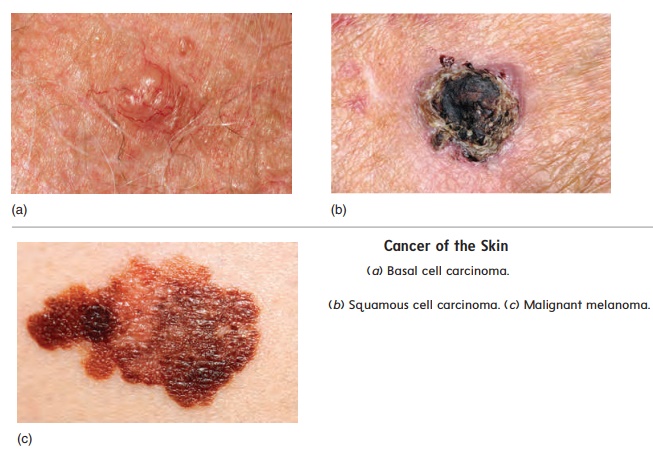Chapter: Essentials of Anatomy and Physiology: Integumentary System
Skin Cancer

SKIN CANCER
Skin cancer is the most common type of cancer. Although chemicals and radiation (x-rays) are known to induce cancer, the development of skin cancer most often is associated with exposure to ultraviolet (UV) light from the sun. Consequently, most skin cancers develop on the face, neck, or hands. The group of people most likely to have skin cancer are fair-skinned (they have less protection from the sun) or older than 50 (they have had long exposure to the sun).
There are three main types of skin cancer. Basal cell carcinoma (kar-si-nō ′mă ), the most frequent type, begins with cells in the stratum basale and extends into the dermis to produce an open ulcer (figure 5.10a). Surgical removal or radiation therapy cures this type of cancer. Fortunately, there is little danger that this type of cancerwill spread, or metastasize, to other areas of the body.Squamous cell carcinoma develops from cells immediatelysuperficial to the stratum basale. Normally, these cells undergo little or no cell division, but in squamous cell carcinoma, the cells continue to divide as they produce keratin. The typical result is a nodular, keratinized tumor confined to the epidermis (figure 5.10b). If untreated, the tumor can invade the dermis, metastasize, and cause death. Malignant melanoma (mel′ă -nō ′mă ) is a rare form of skin cancer that arises from melanocytes, usually in a preexist-ing mole. A mole is an aggregation, or “nest,” of melanocytes. The melanoma can appear as a large, flat, spreading lesion or as a deeply pigmented nodule (figure 5.10c). Metastasis is common, and unless diagnosed and treated early in development, this cancer is often fatal.

Limiting exposure to the sun and using sunscreens that block ultraviolet light can reduce the likelihood of developing skin cancer. Ultraviolet light is classified into two types based on their wavelengths: UVA has a longer wavelength than UVB. Exposure to UVA causes most tanning of the skin but is associated with the development of malignant melanoma. Exposure to UVB causes most burning of the skin and is associated with the development of basal cell and squamous cell carcinomas. It is advisable to use sunscreens that effectively block both UVA and UVB.
Related Topics